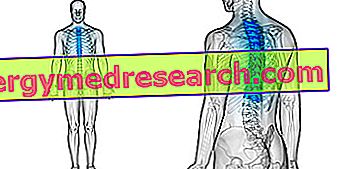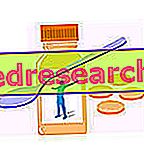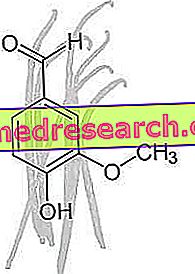What are
What does astringent food mean?
Astringent foods are, as the term suggests, foods with astringent properties.
In chemistry, the term "astringent" indicates the ability to precipitate colloidal proteins in a solute. On the other hand, the same term is used in the nutritional field to indicate the properties of foods and beverages to stick in the mouth and / or to increase the consistency of the stools.
In practice, astringent foods are the most effective non-pharmacological remedy for diarrhea.
See also: Diet and Diarrhea and Example Diet against Diarrhea.

Astringent capacity for precipitation of colloidal proteins
The astringent effect is exercised above all thanks to the combination of high and low molecular weight phenols, and to tannins in the presence of proanthocyanidins (other polyphenols characterized by the oligometric repetition of flavonoids). It is a fairly complex topic, full of technicalities, which however can be summarized and interpreted by the reader as follows:
“The vegetable compounds that exercise the astringent function are those that hang in the mouth (as happens for unripe caco), which color foods (for example the red of grapes and wine) and which, in general, are considered beneficial for health (antioxidants, cholesterol-lowering agents, etc.) ".
Astringent capacity for water absorption in faeces
Secondly, due to their absorbing capacity, even starchy foods with low water content and low fiber residue exert an astringent intestinal action; some examples are boiled potatoes, refined cereals (such as polished rice), isolated starches (such as rice, cornstarch, frumina, tapioca) etc.
Astringent foods
What are astringent foods?
As anticipated, astringent foods are of vegetable origin. In addition to appearing (a sensation felt mainly in the center and behind the tongue), these often have a sweet and / or sour taste.
There are therefore different vegetables, tubers, fruits, aromatic herbs, cereals, legumes (or parts of them) and herbal medicines (barks, roots, etc.) with an astringent capacity. Examples of astringent foods are shown in the table below.
| Astringent foods | |||
Astringent Fruits | Vegetables and Astringent Tubers | Astringent Seeds | Astringent Spices (if they do not irritate the intestinal mucosa) |
Unripe bananas, unripe persimmons, avocado, cranberries, pomegranate (with seeds), prickly pears (with seeds), some varieties of apple, lemon | Alfalfa (alfalfa sprouts), raw carrots (with peel), potato or batata lessa, cassava and various starch powder | Polished rice, popcorn, poppy seeds | Basil, bay leaves, cumin, coriander, dill, fennel, marjoram, nutmeg, oregano, parsley, rosemary, saffron, turmeric, vanilla |
Disputes on astringent foods
One aspect that has been overlooked for many is that many of these foods, in addition to containing astringent nutritional factors, are often also rich in fiber and water (two factors that soften the stool, hindering constipation).
For example, bananas and unripe persimmons (with the exception of the cacomela variety) are highly astringent fruits; this function is lost with maturation, during which certain enzymes convert tannins into fructose. However, bananas but especially persimmons are also rich in fiber and water; this means that, while the unripe banana and caco are mainly astringent, the very mature ones (or the cacomela variety) can instead turn out to be anti-constipates. A cocoa or medium-ripened banana could therefore turn out to be neutral or to emphasize the subjective tendency to constipation or too liquid stools.
Drinks
Astringent drinks: the ultimate solution
The most effective astringent drinks are those obtained from the squeezing of vegetables with the aforementioned properties, or composed of aqueous solutions of active principles (or drugs), phytotherapic.
A classic example of an extracted and astringent drink is pomegranate or prickly pear juice.
Herbal remedies rich in astringent polyphenols on the other hand, contain mainly fruits, seeds, leaves, roots and bark (depending on the case): bearberry, camellia, eucalyptus, hawthorn, witch hazel, horse chestnut, ratania, guarana, oak, cinnamon, fern, late cherry, eugenia etc.
Action
Astringent food mechanism
Astringent mechanism of polyphenols
Polyphenols are therefore responsible for the precipitation of dietary proteins and inactivation of digestive enzymes. This precipitation separates the solid from the liquid part, making it sink in the form of a precipitate based on phenols and proteins. The reaction begins in the bolus, in the mouth, and continues in the intestine (first in the chyme and then in the faeces) where it hinders protein absorption also affecting the digestive enzymes.
To demonstrate the astringent action of polyphenols we can see:
- On the palate: the sensation of dryness, dryness, friction and dough that requires an increase in salivation to facilitate swallowing.
- In the large intestine: more compact and less hydrated stools, often accompanied by an increase in foul-smelling flatulence.
Astringent mechanism of refined starchy foods
As a consequence of the absorbing action of the starches, on the other hand, we note only a late effect caused by the reduction of intestinal peristalsis (due to lack of fiber) and an increase in fecal consistency.
It must however be remembered that the latter astringent mechanism produces quite subjective effects; in fact, the digestive tract reacts spontaneously to the dryness of foods releasing water in digestive juices in adequate quantities. Reducing fiber (low residue diet) and increasing refined starches is not an immediate remedy, but rather a basic rule of diet against diarrhea.
Benefits
What are astringent foods for?
Astringent foods fight enteritis, the symptom of diarrhea, inflammatory states of chronic diseases (Crohn's disease, ulcerative colitis), ulcers and metal intoxication; the mechanisms of action that regulate these effects are:
- They reduce water in the faeces
- Intestinal peristalsis decreases (due to reduced nervous sensitivity)
- They are anti-inflammatory (as well as for the intestine, blandly also for the esophagus and stomach)
- The protein molecules of the bacteria precipitate and the irritants complex
- Mucous secretions decrease (see Mucus in Feces)
- By binding, they protect the surfaces of ulcerative lesions and promote haemostasis by optimizing coagulation
- Chelator on metals such as aluminum, iron, copper, manganese and vanadium (normally the chelating action on alimentary iron is considered anti-nutritional but in the pathology of hemochromatosis is instead therapeutic).
Side effects
Do too many astringent foods hurt?
- In case of excessive intake of polyphenols and / or reduction in fiber and / or edible water, the astringent action may be excessive, predisposing to constipation.
- Moreover, the lack of protein absorption in the small intestine (caused by the bonding of the polyphenols with the food peptides and with the digestive enzymes on the mucosa) tends to increase their concentration up to the colon, where the bacteria process them with consequent onset of meteorism, tension abdominal and flatulence.
- The chelating action of phenols on minerals reduces absorption, favoring above all iron deficiency. Furthermore, the inhibition of digestive enzymes (proteases) decreases the nutritional absorption of peptide amino acids.
- An excess of tannins can be counterproductive in the case of severe inflammatory and ulcerative lesions of the digestive tract; furthermore, some statistical data indicate a correlation (unclear but present) between excess tannins and gastrointestinal tumors.
- The polyphenol molecules also precipitate alkaloids and decrease the action of the drugs that contain them.



